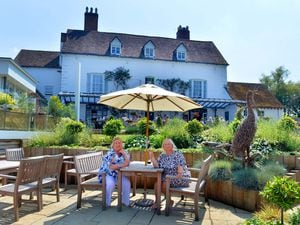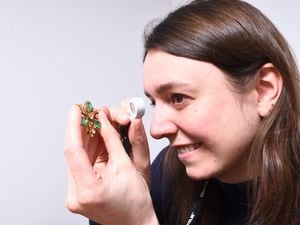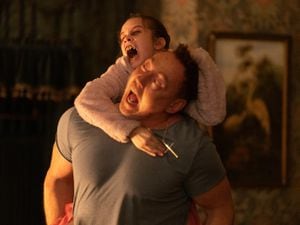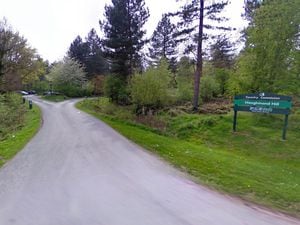Annie cooks up a Victorian Christmas
Looking forward to your turkey dinner this Christmas, followed by a Marks & Spencer Christmas pudding, topped off with generous helpings of brandy butter?

Then don't, whatever you do, invite Annie Gray along to join you.
"Turkey is vile," says the waspish food historian and broadcaster, who will be on our screens later this month with a new BBC2 show filmed at Ironbridge.
"If we as a race really liked turkey so much, we wouldn't just have it on Christmas Day, we would have it all year round."
"Roast chicken's fine, a really good turkey's fine, but most of the turkey people eat at Christmas is really bad, it comes from the supermarket frozen, and is cooked to death with burned legs.
"If you are going to cook turkey for dinner, take the legs off and cook them separately so they're not overcooked."
Annie is speaking to a sell-out crowd of 300 at Ironbridge Gorge Museum's Engine House at Coalbrookdale. The Gorge's Blists Hill Victorian Village is also the setting of her new television programme The Sweet Makers at Christmas, which will go out on December 15.
She is talking about Christmas cooking through the ages, with particular reference to the Victorian period typified by the famous Mrs Beeton's cookery books, and says we could learn a thing or two from our forebears when it comes to having a good time over the festive period.
In ages gone by, Christmas pudding would be made with beef, and would be served as one of several main courses, not as a dessert.
"Why save your Christmas pudding until you have already eaten too much, and you don't want it?" she says.
"And don't, whatever you do, have brandy butter with it, brandy butter is horrible, it is an abomination."
The Christmas feast has had something of a chequered history over the centuries, says Annie. In the Middle Ages it was largely eschewed in polite society – at least in public.
"It was seen as a time of gluttony, harlotry and lechery, something that was largely confined to the lower orders," she says, although that is not to say that the upper echelons did not participate in a bit of gluttony and lechery behind closed doors.
"In the medieval period, Christmas did not really get going until December 24, and it would then go on for the full 12 days of Christmas.
There is evidence that minced pies were consumed as early as Tudor times, although they were somewhat different from Mr Kipling's vision of what they should be.
"They were about 12in across and contained one-third meat," she says.
Oliver Cromwell's Puritanical rule meant that the riotous Christmas celebrations of old largely went by the board, although contrary to popular myth he never stopped people from celebrating.
"There's not truth to the rumour that he banned Christmas," says Annie. "Although those people who celebrated Christmas with lots of food were at risk of having lots of soldiers banging on their door."
Annie says the first record of turkey being eaten for Christmas dinner was in 1526, although it did really become established as the definitive festive meal until the 1960s.
"It came over from America, from the Thanksgiving celebrations. Before that it was one of many things that people might eat at Christmas."
Annie says the modern festivities owe much to the Victorian era, typified by the famous Mrs Beeton's cookery book, or Book of Household Management to give it its full name.
"The influence that Isabella Beeton had on how we celebrate Christmas is practically zero, but the Victorians had a big influence," she says.
"Isabella only lived to be 28, and she stole all her information from other sources.
"Most of her recipes came from Eliza Acton, she was basically a woman with a library, she had no shame.
"She is often credited as being the first to list the ingredients in her recipes, but she wasn't that was Eliza Acton
What she did have, though, was a knack of being able to connect with the aspirational housewives of the day. Her books made no claim that the recipes were original, but it didn't matter. Her achievement was to bring together everything that the would-be perfect hostess could possibly need, and it went down a storm with the lower-middle classes who sought to elevate their place in society.
"It sold extremely well, she sold 60,000 copies in the first year," says Annie.
"She knew her audience so well, people that had been born working-class, had worked their way up to the lower-middle classes, and perhaps hoped to become part of the middle-middle class.
"The sort of person who knew their husband might come back from a day working at the bank with some stranger, and who needed to cook a dinner that would help get him a promotion."
The 1888 edition of her cook book proposed a four-course "seasonal dinner" for December meal, starting with soup, fish, and maybe a calf's head. It would be followed by lobster and sweetbreads, with ham, sprouts and game pie in celery sauce coming after that, with the rather strange combination of plum pudding, pheasant, blancmange and wild duck making up the fourth course."
Mrs Beaton also gave a detailed description on how to cook a pig's head, which was a sort of poor man's alternative to the boar's head which would have been displayed on the tables in fashionable society.
"If you want to try the boar's head, the important thing is to sew the eyes and mouth up, otherwise you will have meat seeping out when you come to stuff it," she says.
It seems hard to see any animal's head taking the place of the traditional turkey for the average household in Shropshire, but Annie urges people to take a leaf out of Mrs Beeton's book, and try something a bit more adventurous this Christmas.
"I think these days we get so hung up on keeping traditions, but the traditions themselves are really not that old," she says.
"We should chill out a bit more. People have ate almost everything at Christmas at some time through history. We don't need to stick to turkey, sprouts and Christmas pudding."





